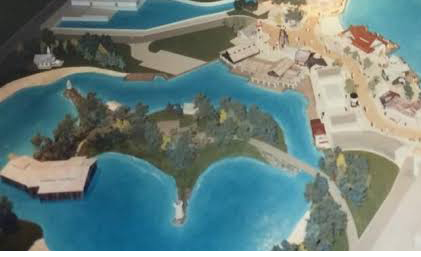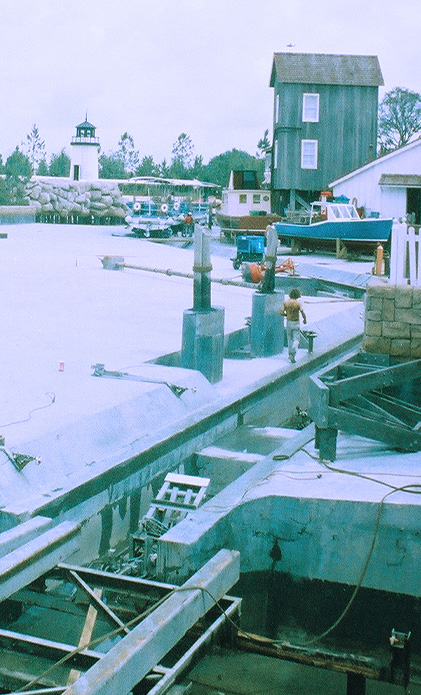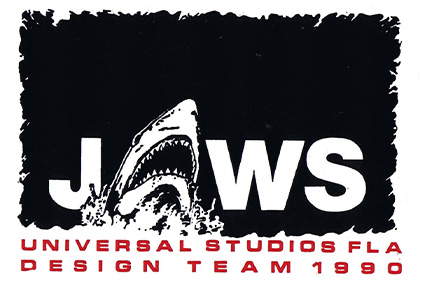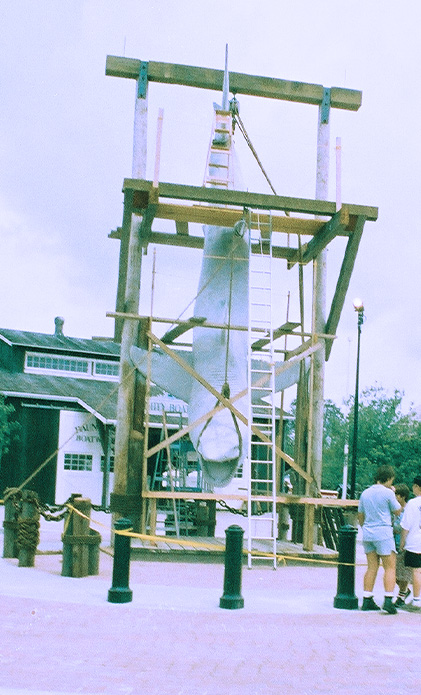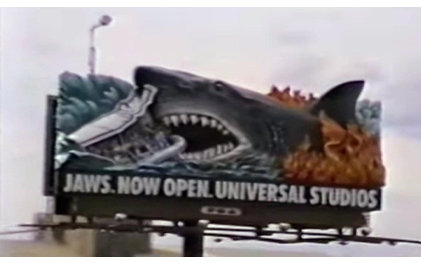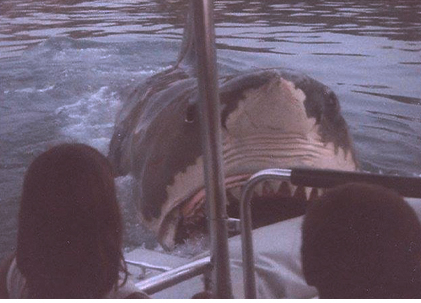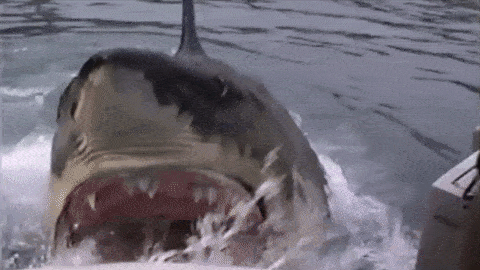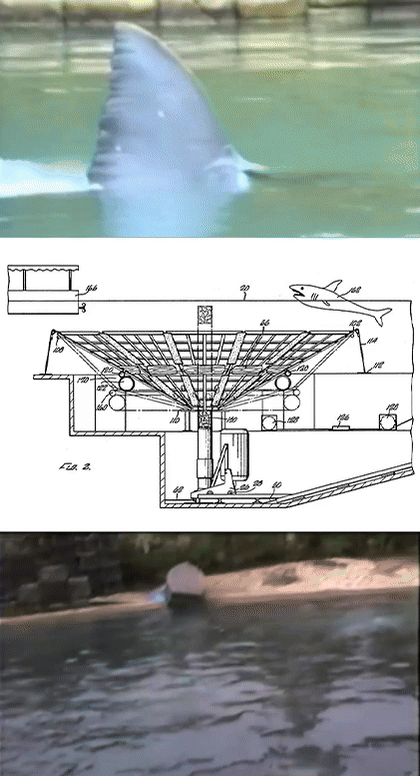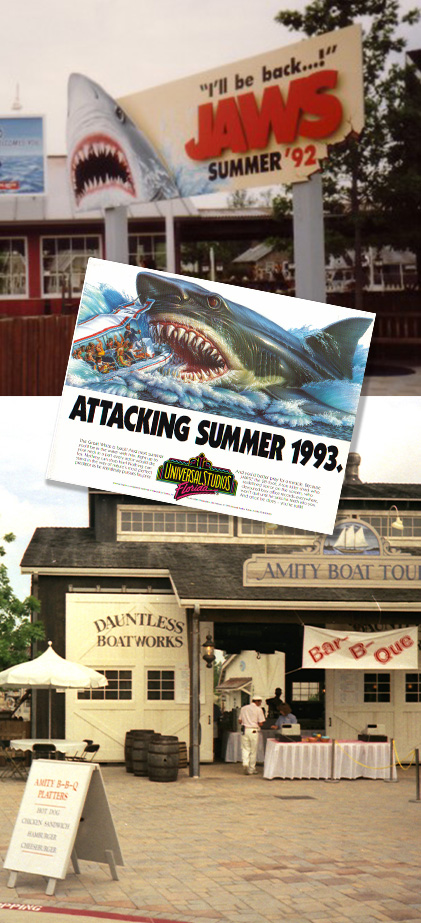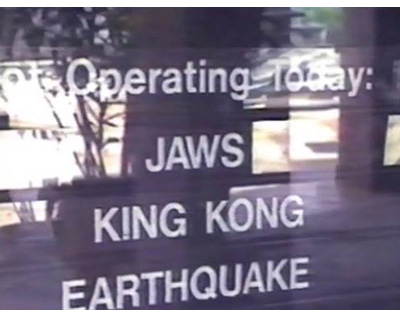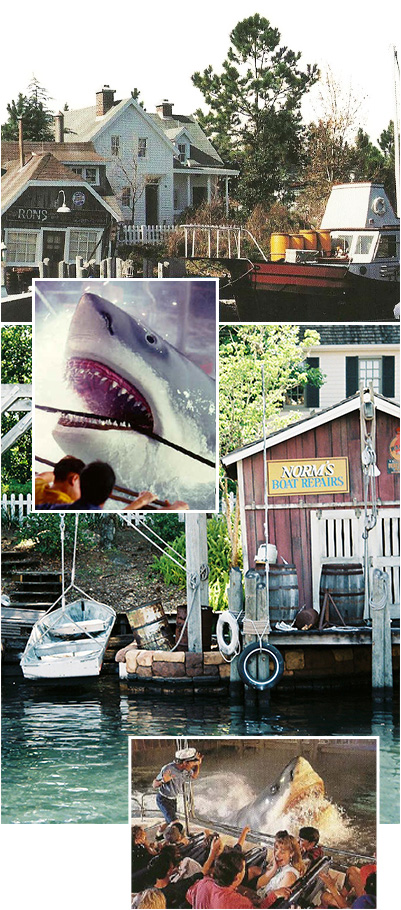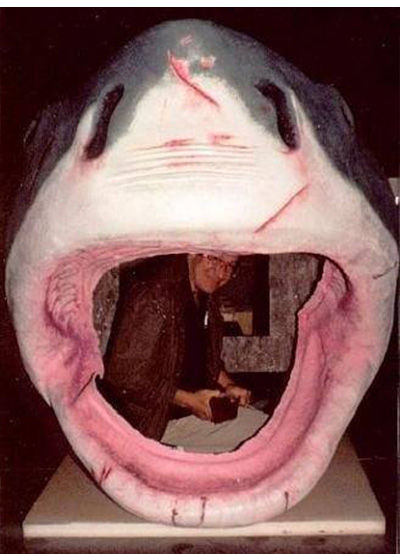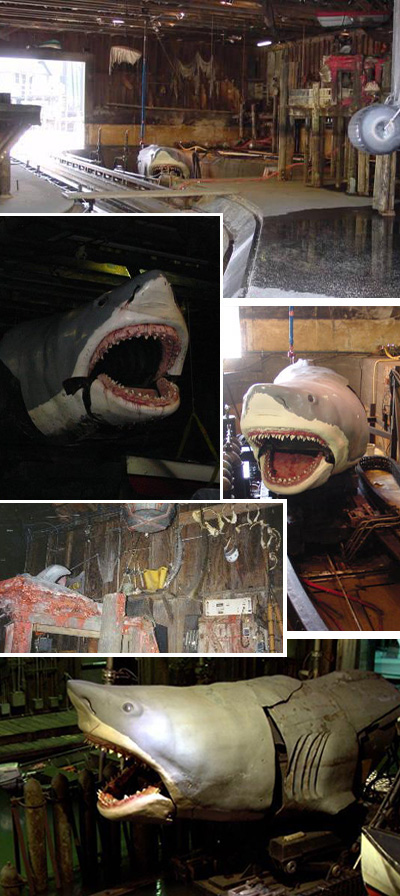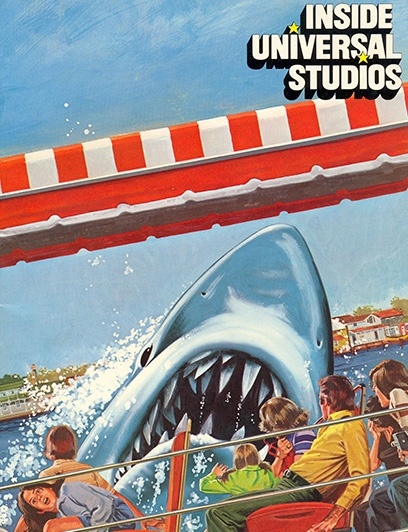Grand Opening 1990
With the opening of Universal Studios Florida on June 7th 1990, the company had a public relations nightmare on its hands. Some of the most highly-touted rides -- Kongfrontation, Earthquake and JAWS weren't ready. The original JAWS ride design kept having major problems and after a few months, Universal closed it, blaming mechanical difficulties.

Peter Alexander a former college roommate of Steven Spielberg's created the original ride and the initial concept for the redo. Alexander worked closely on the park's design with both Spielberg and MCA Inc. President Sidney Sheinberg. From an exclusive interview with AmityIsland.net (now JawsRide.net), Peter gives us an insight into how the ride originally came about:
"Sheinberg comes up to me with that cigar in mouth, and says 'In every shark picture, the shark blows up in the end.' So, I found someone who could make a shark blow up every 60 seconds.
Originally, I wanted to make Jaws just one scene in a longer water ride, but my boss, Jay Stein, figured the movie was worth a whole ride (I actually had Bill Martin, who designed the castles for Disneyland and Disney World, lay out my longer water ride).
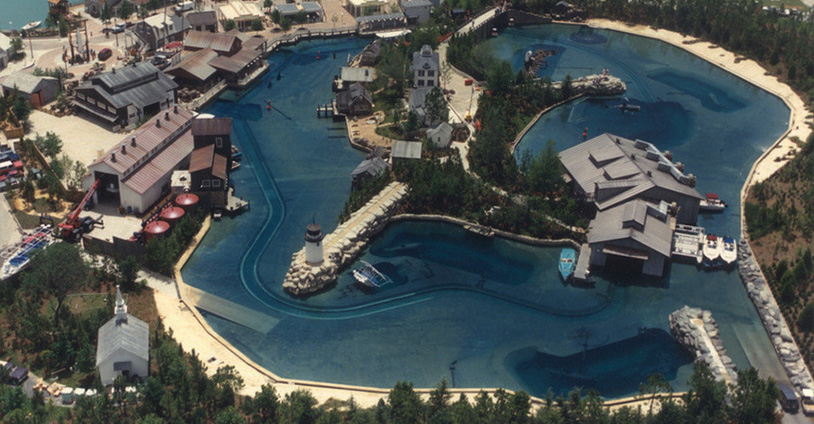
So I came up with an 'all Jaws' design, including the 'shark bites boat' scene. I asked my friend Tom Reidenbach to lay out the action for what went on inside the boathouse (which is still the same today). At first, like most of the rides we did, the design was only represented by me telling the story-line (live) and a bunch of story boards. Later I had two guys named Rick and Rick write the script (it was my live "pitch" word for word) and they went on to become theme park designers just based on that... or maybe based on a little elaboration of their actual role.
As the design progressed, we designed the set in-house, and then had 'Ride and Show Engineering' build the sharks and ride, but they mis-specced some of the underwater parts and the ride proved unreliable.
After we opened, everything else seemed like such a big hit that we felt we didn't need to re-engineer the 'shark bites boat' or 'meat machine' to make them more reliable, so I came up with the simpler 'Shark bites wire, catches fire' bit. After that, I left Universal and a guy named Adam Bezark took it from there."
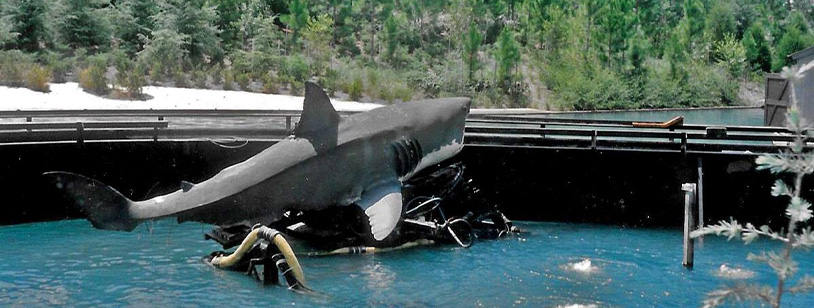
The 'shark bites boat' animatronic
Show Director Adam Bezark continues our story: "I was brought in during the production phase, after the new sharks/boats had been designed and were already in construction. My role was to bring the whole thing together: fine-tune the script, program the boats and sharks, work out the effects timings and lighting, oversee the new soundtrack and train the performers, etc.
One of my favourite tasks was to program the fire sequence. I sat in a rowboat which was anchored in the spot where the show boats would go. Ron Griffin, the fire effects guy, sat in the control room behind the dock, setting off the sequence again and again, while we adjusted the height and duration of the flames. I wanted to make it intense and scary, but not dangerous; so I kept making Ron turn the fire up higher and higher. When it got to the point where the heat was actually painful, we dialled it back just a bit. So the impact on the audience was amazing: some people thought they were actually getting burned, but I knew from personal experience that it was safe, even for prolonged exposure. (Of course, some people with sunburns are more sensitive to heat, so they might be more uncomfortable.)
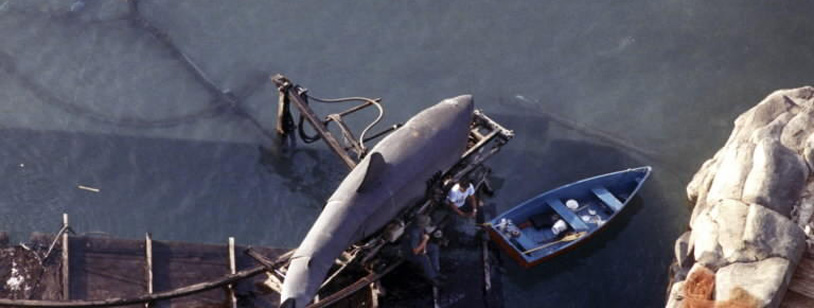
Workers used rowboats to get to the shark animatronics
I also spent many happy (and long) nights in the JAWS lagoon, programming the complex passenger boats with technical sorcerer Marc Plogstedt. A show control system regulates their speed precisely, and provides the rolling effects that (hopefully) feel like they're being created by the shark swimming by or under the boat. Programming the boats was an incredibly tedious process; there was no way to back the boats up, so if we wanted to change a roll effect in, say, scene one, we'd have to ride the entire six-minute ride all the way around the lagoon before we could see the results of the change. This meant literally hundreds of cycles, always taking place in the dead of night (so the other crews could work during the day.) Marc and I were alone in the programming boat, slowly losing our marbles."
Meat Machine (1990)
The final scene of the 1990 version has the skipper deftly shoot their grenade launcher at the sharks open mouth causing the shark to explode into a fountain of blood and fish guts. This underwater explosion effect simulator includes a submerged shooter for shooting props (shark flesh) and red dye-coloured water through the water surface. The following describes how it works:
A compressed air source is linked to the shooter to drive the charge of water from the shooter during the explosion sequence. Shark flesh pieces are ejected from the shooter through the water surface and trajectories over a submerged collector substantially surrounding the shooter. The collector is displaceable through an underwater winching system from a collect position wherein the shark flesh settle onto the collector to a funnel position wherein the shark flesh fall under gravity back into the shooter. The shooter extends from a loading position below the collector to a shooting position close to the water surface.
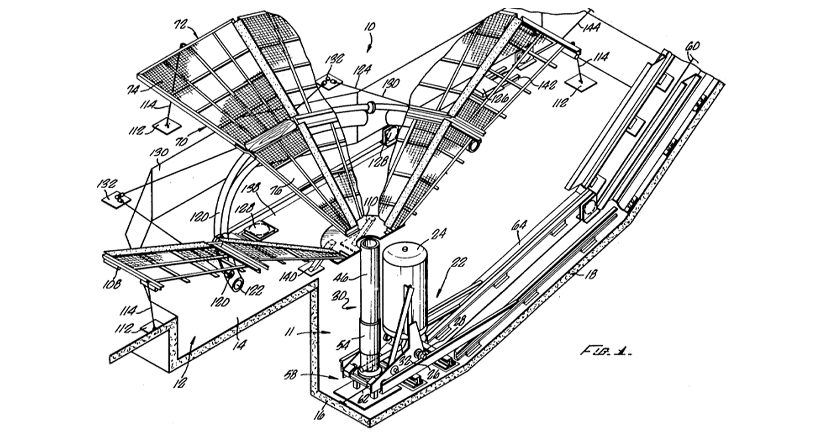
Meat Machine drawings from the patent filed on 20th Feb 1991
In July 1990, a 39-year-old man fell into the water while riding after a boat railing allegedly broke. There were no serious injuries, and he sued Universal for $1 million claiming negligence and poor maintenance.
Orlando Sentinel Newspaper March 9, 1992

Ride Complications (1991-1993)
In 1991, Universal were planning on spending big bucks to have the ride fixed for the 1992 season and had lots of signs on the ride building that said so (coming 1992). But in 1992, the ride was boarded up and had no signs what-so-ever. The ride was deemed totally un-usable and the design was completely flawed. Universal had successfully sued Ride & Show Engineering, claiming the company had placed non-waterproof parts underwater, causing the constant failures in ride elements. The suit was settled for an undisclosed amount the following year, but Ride & Show insisted the real problem was that Universal didn’t allow enough time for testing.
“Basically, Universal didn’t have any experience with a ride like this,” Ride & Show CEO Eduard Feuer told the Orlando Sentinel in October 1993. “If we had built something like this for Disneyland, Disneyland maintenance would have taken it over and made it work.”

The technical complication of the shark attacking the boat was a big factor in why the ride eventually was shut down and re-designed... The skippers were in full control of the boat's throttle. "You can imagine how complex it must be to get one giant mechanical watercraft to swim up and bite another giant mechanical watercraft -- which is MOVING -- with absolute precision, hundreds of times per day." Said Show Director Adam Bezark. The only tracks and such were scrapped and the ride was recreated all over again, while trying to use the same layout and some of the same sets and gimmicks when applicable. Between the original construction and that overhaul, Universal may have spent US$70 million, outside industry sources estimated.
The second version had a soft opening in September 1993; With Universal allowing more than 500,000 guests to experience “technical rehearsals” of the ride for three months before it officially opened.
Second Version (1993-2012)
Universal collaborated with Totally Fun Company, ITEC Entertainment, Intamin, and Oceaneering International, to install an entirely new ride system with modified special effects. One change resulted in the first scene, where Jaws bit onto the tour boat and turned it 180 degrees, to be replaced with a gas dock explosion scene. Another change was with the finale, which was originally based on the ending of the first film. Instead of simulating the firing of a rifle at an air tank in the shark's mouth, the scene was replaced by one loosely based on the ending for Jaws 2, where the shark is electrocuted after biting an underwater cable attached to a high-voltage barge.
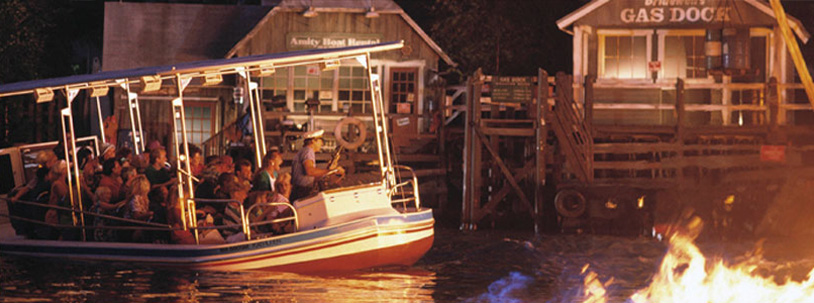
JAWS after dark was a completely different experience
In September 2005, JAWS went down to "seasonal" status, operating only during busy weeks. This was due to the rising costs of fuel and the attraction used a lot of gas for fire effects.
Universal reopened the attraction on February 4th 2007 due to numerous complaints of its part time closure.
For the reopening the ride had been improved, the queue had been cleaned, the boats had been repainted, the sharks thrashed around and were bloodied up and repainted to make them feel much more realistic. However the fire effects were reduced.
The ride officially closed on January 2nd 2012 at 9:00 pm with Michael Skipper aka "Skip" giving the final voyage to the last lucky group of 48 guests. By the next morning, the entire Amity area was walled off and completely demolished in the following months. Visit the Orlando Sky Radio site for more demolition photos.
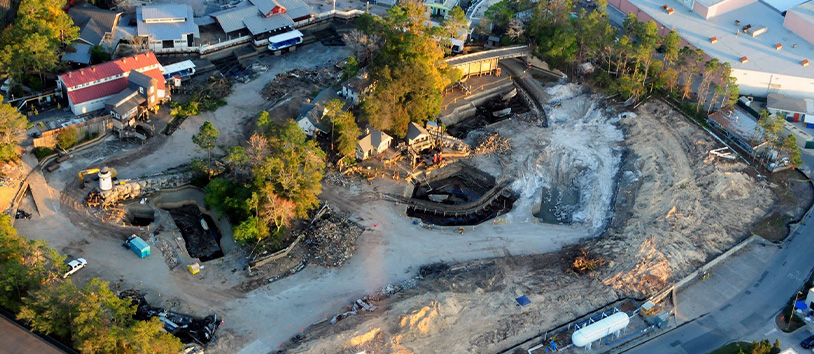
Carrot Tooth with the Psycho House in the background (1977)
Shark skins
In 1992 when Universal Studios started the task of redesigning the ride they hired a company called Kinetix to work on the shark skins. The skins were made of latex, sprayed in many layers onto the inside of a giant fibreglass mold. The skins were about 1/2 an inch thick and were literally pulled over the hydraulic steel shark mechanisms, the teeth were painted urethane.
Painter Luke Sawh talks to AmityIsland.net (JawsRide.net) about the project: "My painting was done under the art direction of Lee Nestler, a freelance art director who worked for Universal at that time. There were some technical problems initially with the interaction of the skins with the mechanism. Some skins were destroyed during the testing phase. I painted approximately 7 flexible skins as well as some of the smaller fibreglass sharks that are seen from a distance on the ride. The 'Dead Shark' required the most amount of work due to the level of detail depicting its demise. The texturing effects were done using fibreglass and body filler materials."
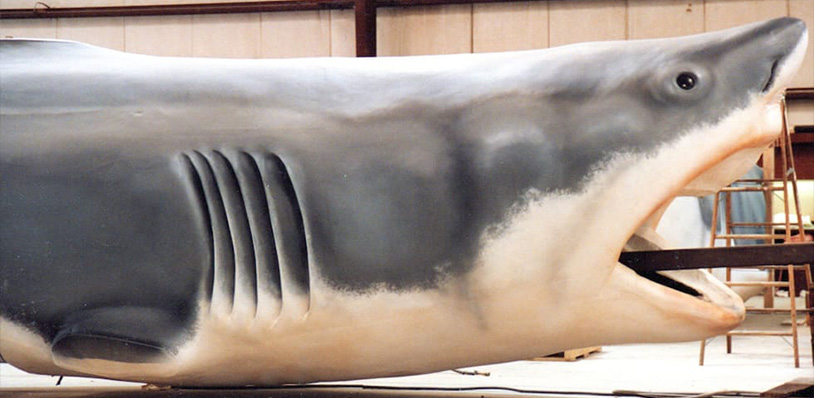
One of the skins that Luke painted in the workshop
The gills were eventually removed from the big shark sculpt as they proved to be a weakness on the skin. The hydraulic mechanisms were tearing the skins in these areas, so on all subsequent skins Luke painted the gills onto a smooth surface.
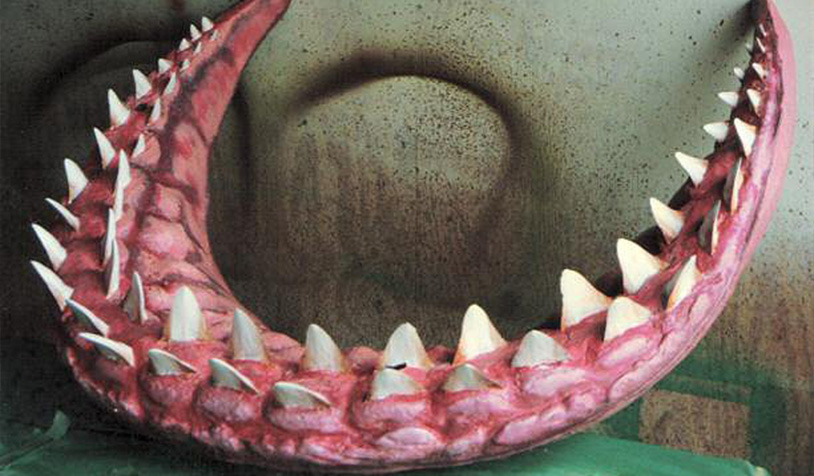
Upper teeth set that Luke painted
One one of many sets of shark teeth that Luke worked on. "As far as I know, the original set was produced at Universal, CA. The teeth from the original sculpt were molded from actual sharks teeth. Probably a prehistoric shark as the teeth measured over 3 inches long without the root."
Mechanical Sharks
The sharks move through the water at speeds of up to 20 feet per second, and thrust with the power equal to that of a 727 jet engine.
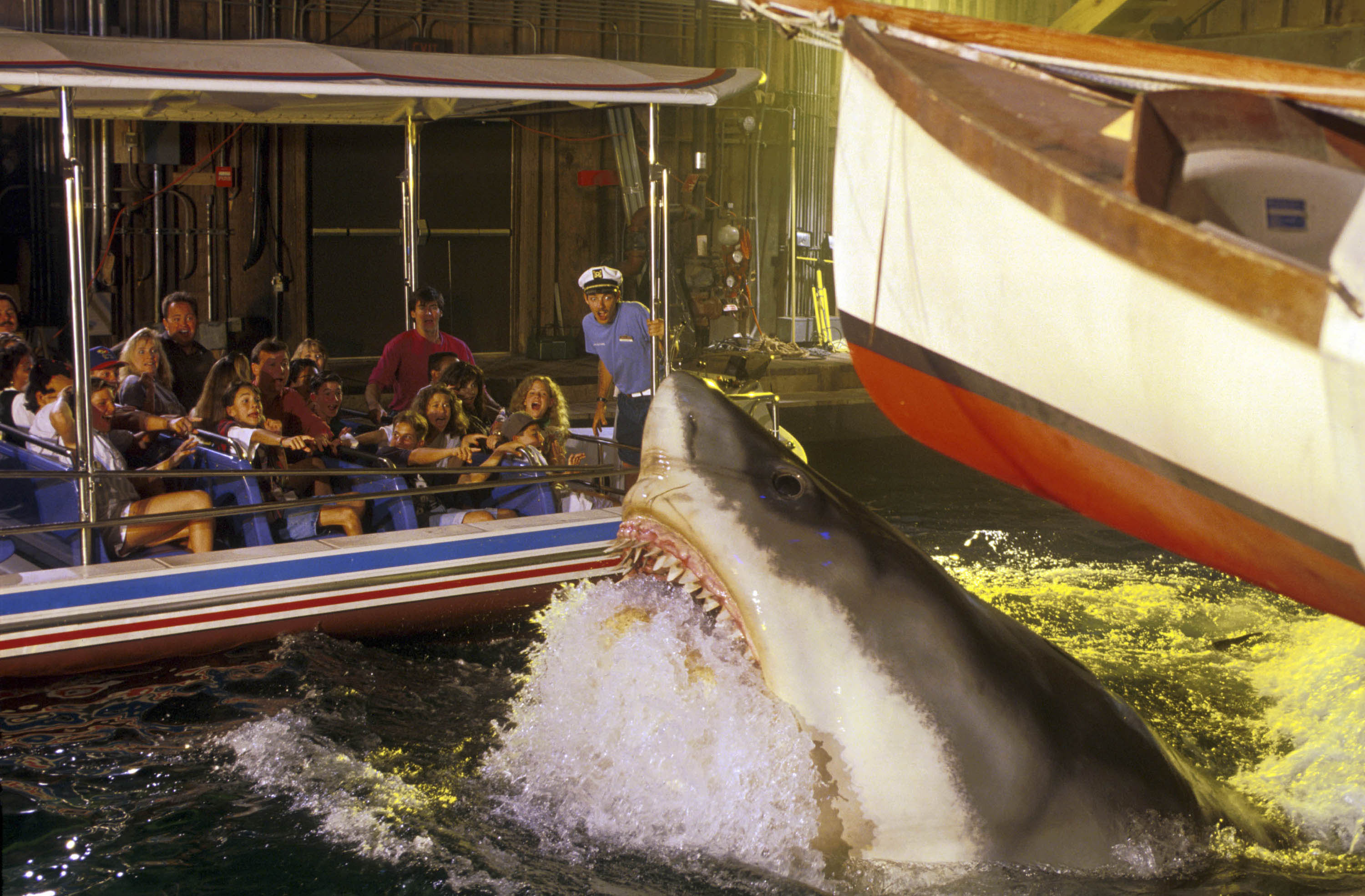
Boathouse
The 1990 boathouse was referred to as ‘Jay’s Boathouse’ named after Jay Stein, founder of Universal Studios Florida. The boathouse is where you’re forced to take refuge when trying to escape the shark. Just when you think you’re safe, the shark smashes inside, creating a hole in the wall and causing hanging boats to crash into the water.

The second version dropped the shark smashing a hole in the wall effect. However it gained over 70 lighting elements, a couple of water barrels to get you wet and many eerie objects such as a shark carcass.
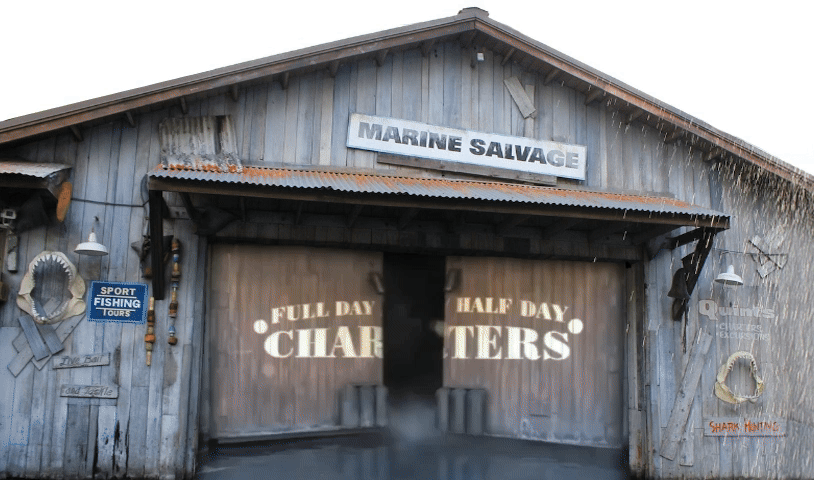
Hanging Shark photo op
The photo opportunity hanging shark has been in Amity outside the attraction from day one. When the ride closed in 2012 Universal had the hanging shark relocated instead of removing it completely. The shark now resides in the part of the park themed as San Francisco.
In 2015 the famous tornado of sharks from the movie Sharknado 3 hits Universal Studios Florida and Islands of Adventure. Unfortunately it was 3 years too late to feature the JAWS ride, however, not to completely disappoint fans, the hanging shark features quite nicely as seen below.
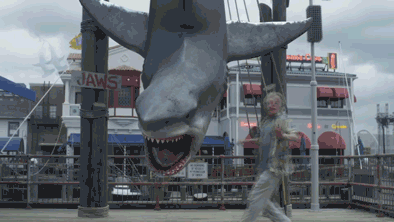
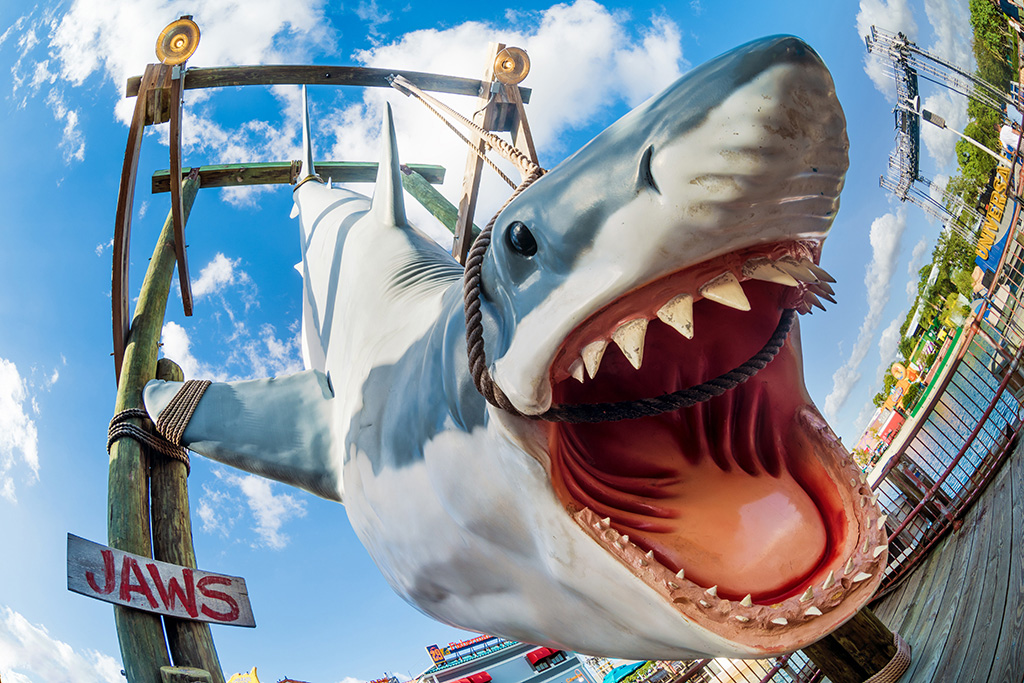
Ride Queue
The attraction queue was designed to hold up to 1000 people for 90 minutes, as you walk through the queue you passed props from the movie JAWS, such as chief Brody's jacket and Quint's fishing rod. You also passed two boats which were used in the movie JAWS The Revenge: 'Neptune's Folly' and 'Amity Police Boat'. You could get a better view of the two boats when you exited the attraction as seen below.
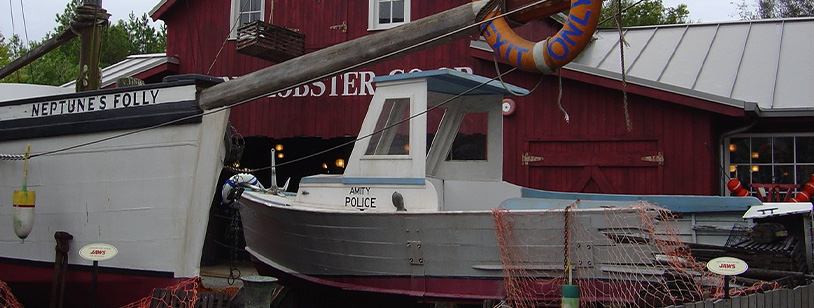
Screen used boats from JAWS The Revenge 'Neptunes Folly' & 'Amity Police Boat' (2005)
The queue video is a made up broadcast of WJWS Channel 13, a local Amity television channel. It's a 52 mintue long loop, always airing an episode of "Hey There Amity", a magazine news show commemorating the 1974 shark attacks. It also features ads for other programming on the network and local businesses in Amity as if it was a real station.
Advertisements for Captain Jake's Amity Boat Tours featured on the video show aspects of the ride as they were in 1990 that have since changed, including the skippers wearing white hats and boats having curved canopies (changed to flat in 1993).
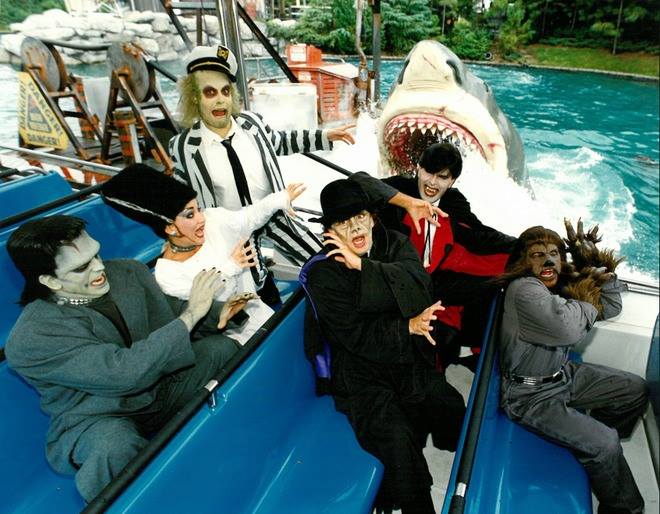
The sharks move through the water at speeds of up to 20 feet per second, and thrust with the power equal to that of a 727 jet engine.
Park Maps
The JAWS Lake featured in several park maps and souvenir brochures through the years.

Top: 1983, Bottom Left 1976, Bottom Middle 1985, Bottom Right 1978







